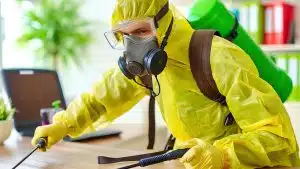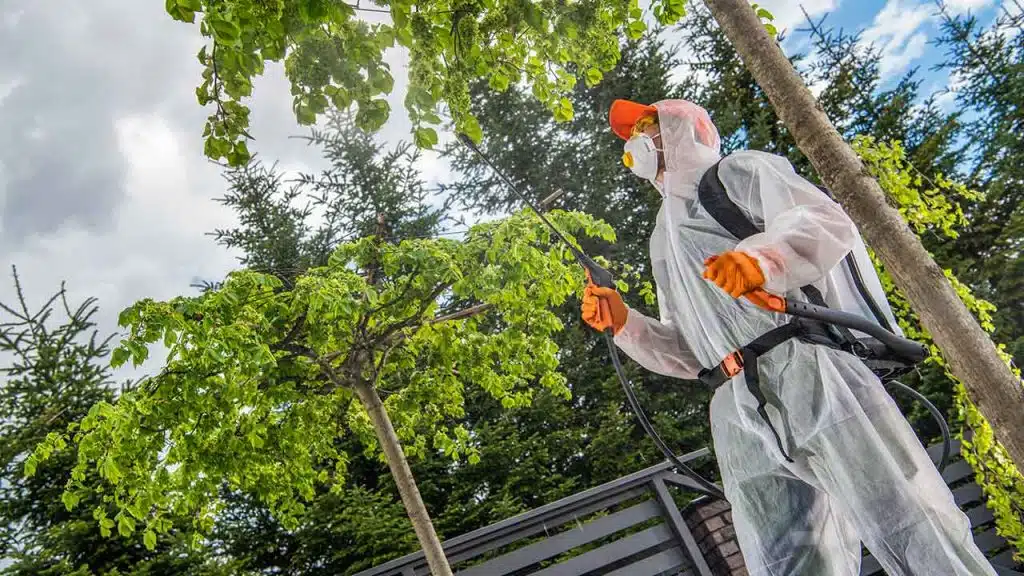


Do it yourself pest control is an effective way to manage pests without professional help. It requires knowledge of pest behavior and appropriate treatment methods.

Tackling pest control on your own can be a daunting task, but with the right information and tools, it’s entirely possible to keep your home pest-free. This approach can be cost-effective and allows for immediate action. Before diving into DIY pest management, it’s important to identify the pests accurately and understand their life cycle.
This will determine the most effective treatment plan. Safety is paramount; always use pesticides according to the label instructions and wear protective gear when necessary. By taking a proactive stance and regularly maintaining your space, you can prevent infestations and address issues as they arise, keeping your home safe and comfortable.
The Rise of DIY Pest Control has taken the world by storm. Homeowners and renters alike are embracing the challenge to tackle pest problems independently. This movement stems from the desire for more control, customization, and savings. Let’s delve into the key factors that contribute to the growing popularity of DIY pest control.
DIY pest control offers significant cost savings compared to hiring professionals. With the right approach, individuals can effectively manage pests at a fraction of the cost.
Reduced Labor Costs: No need to pay for professional services.
Price Comparison: Freedom to shop around for the best deals on products.
Bulk Purchases: Savings on buying in larger quantities for long-term use.
Today, resources for DIY pest control are more accessible than ever. The internet provides a wealth of information, tutorials, and products at our fingertips.
Online Tutorials: Step-by-step guides make it easy to learn.
Pest Control Communities: Online forums offer support and advice.
Product Availability: A wide range of products can be delivered to your door.
Credit: www.erdyes.com
dentifying common household pests is the first step in effective DIY pest control. Knowing what you’re dealing with helps you choose the best approach. Let’s explore some usual suspects.
Insects and arachnids often invade homes. Here are some common ones:
Ants: Small and dark, often found in kitchens.
Cockroaches: Brown or black, they avoid light.
Spiders: Many types, some with harmful bites.
Bedbugs: Tiny, hide in mattresses, bite at night.
Use sticky traps to catch these pests. Check traps daily. Note what you find.
Rodents and small mammals also cause trouble. Recognize them by these signs:
Pest | Signs |
|---|---|
Mice | Small droppings, chewed wires, nesting materials. |
Rats | Larger droppings, grease marks on walls, burrows. |
Squirrels | Noises in attics, gnawed holes, food theft. |
For these pests, seal entry points. Use traps outside entry points. Check daily.
A pest-free home offers peace and safety for your family. Taking proactive steps can keep unwelcome visitors at bay. Focus on regular upkeep and sealing your home to maintain a pest-free environment. Let’s explore effective preventative measures.
Pests thrive in untidy spaces. Regular cleaning is essential. Keep your home tidy to deter pests.
Dispose of garbage promptly and securely.
Clean spills and crumbs immediately to avoid attraction.
Store food in sealed containers to keep pests out.
Vacuum regularly to remove potential food sources.
Trim plants and branches near your home to limit access.
Consistent cleanliness disrupts pest habitats and deters infestation.
Cracks and gaps invite pests inside. Seal them to protect your home.
Area | Action |
|---|---|
Doors | Install door sweeps and weather stripping. |
Windows | Seal gaps with caulk or weatherproofing. |
Walls | Fill cracks with plaster or silicone sealant. |
Roof | Check for loose shingles and repair them. |
Pipes | Seal around pipes and cables entering your home. |
Sealing entry points keeps pests outside where they belong.
Credit: www.theoriginaldoityourselfpest.com
Tackling pests in your home doesn’t always require harsh chemicals. Natural solutions for pest management can be both effective and safe. These methods protect your health and the environment.
Plants and herbs can keep pests away. They are natural and smell nice. Here are some you can use:
Mint – Keeps mice and ants away.
Lavender – Deters moths, fleas, and flies.
Lemongrass – Repels mosquitoes.
Plant these herbs around your home or use their oils. They work well.
You can also make traps and baits. They catch or kill pests. See below for easy ones:
Pest | DIY Solution |
|---|---|
Ants | Mix sugar and baking soda. Place near ants. |
Flies | Use a mix of water, sugar, and apple cider vinegar. |
Mice | Small box with peanut butter. It traps them. |
These solutions are easy to make. They help control pests.
Chemical Pest Control: Safety and Usage is crucial for homeowners. It helps you fight pests without harm. Learn how to use chemicals right and stay safe.
Read labels carefully. They tell you what pests it kills.
Pick environment-friendly options. They are safer for you and pets.
Use specific chemicals for specific pests. One size does not fit all.
Using chemicals the right way is key. Follow these tips:
Wear protection like gloves and masks. Safety first!
Follow the product’s instructions. This ensures best results.
Keep kids and pets away until the area is safe.
Store chemicals in a safe place. Out of reach is best.
Do | Don’t |
|---|---|
Read labels | Use without gloves |
Wear safety gear | Mix chemicals |
Store safely | Ignore instructions |
Technological Innovations in Pest Control are revolutionizing how we deal with unwanted guests. Pests can be annoying and harmful. Traditional methods often use chemicals. Today, technology offers safer and smarter solutions. Let’s explore some cutting-edge tools that are changing the pest control game.
Ultrasonic devices are the new kids on the block. They emit high-frequency sound waves. These sounds are too high for humans to hear. But they are a nightmare for pests. The waves create an uncomfortable environment. This forces pests to flee. These devices are non-toxic and safe for pets. They are perfect for homes, offices, and warehouses.
Bold advantage: No chemicals used.
Safe for children and pets.
Easy to install and use.
Smart traps are a game-changer. They are the perfect blend of technology and traditional trapping. These traps connect to the internet. They send alerts when a pest is caught. This means no more checking traps daily. Smart traps also collect data. This helps understand pest behavior better.
Feature | Benefit |
|---|---|
Real-time alerts | Save time and effort |
Data collection | Better pest management |
DIY pest control can save money and time. Sometimes, pests need professional help. This section helps you decide when to call the professionals.
Knowing the pest type and infestation size is key. Small problems often need simple solutions. Big problems require experts. Look for these signs:
Many pests in your home
Damage to your house or things
Pests come back after DIY treatment
Act fast if pests harm your health or home.
Experts bring tools, knowledge, and skills. They offer:
Benefit | Description |
|---|---|
Quick results | Experts act fast and effectively. |
Safe methods | They use safe products for your family and pets. |
Lasting solutions | Professionals aim to prevent future infestations. |
Experts save you time, stress, and often money in the long run.
Once you’ve treated your home for pests, the real work begins. Keeping bugs at bay requires diligence and strategy. A pest-free environment is crucial for your peace of mind and health.
Regular checks are key in spotting early signs of pests. Look for droppings, nesting material, or damage to wood and fabric. Use a flashlight to inspect dark corners, behind appliances, and inside cabinets.
Monthly inspections prevent infestations.
Check indoors and outdoors.
Identify and seal entry points.
Prevention is more effective than treatment. Use these strategies to keep pests out for good.
Strategy | Details |
|---|---|
Seal Cracks | Fill gaps in walls, windows, and doors. |
Trash Management | Secure lids; dispose of garbage regularly. |
Food Storage | Keep food in airtight containers. |
Trim plants near the house.
Use door sweeps on all exterior doors.
Fix leaky pipes and faucets.
Remember, diligence in maintenance is your best defense against future pest problems. Stay vigilant with inspections and employ prevention strategies to ensure your home remains a pest-free sanctuary.
Credit: diypestcontrol.com
Tackling pests on your own can be rewarding and cost-effective. By using the tips and tricks outlined in this guide, you're well-equipped to handle common household invaders. Remember, consistency and preventive measures are key to keeping pests at bay. Embrace the challenge of DIY pest control and enjoy a pest-free home.
DIY pest control can be effective for minor infestations using the right products and methods, but professional help may be needed for larger issues.
Common methods include setting traps, using natural repellents, applying chemical treatments, and maintaining a clean environment to deter pests.
Regular pest control should be performed seasonally or as needed, depending on the pest type and the severity of the infestation.
Yes, natural remedies like essential oils, diatomaceous earth, and homemade sprays can help manage pests without harsh chemicals.
Always read labels carefully, wear protective gear, and ensure proper ventilation when using chemical treatments for pest control.